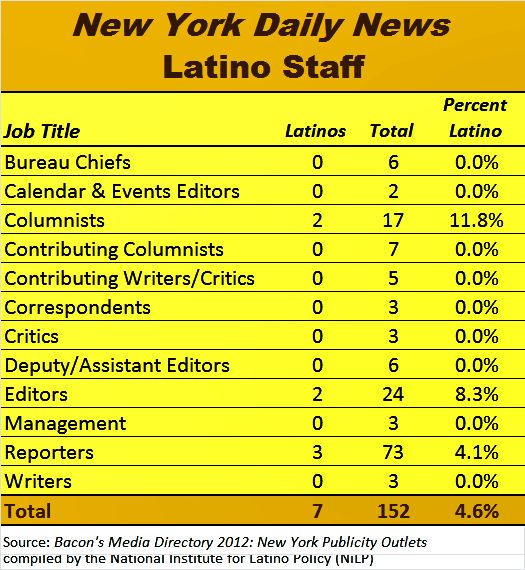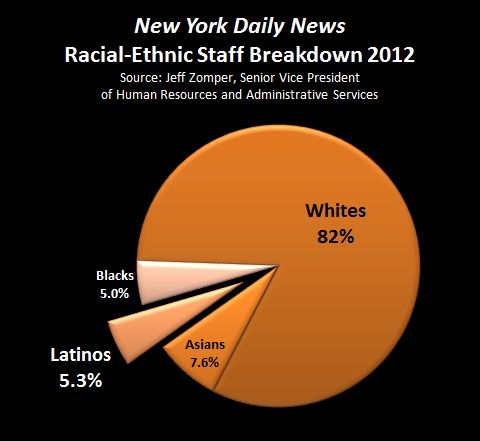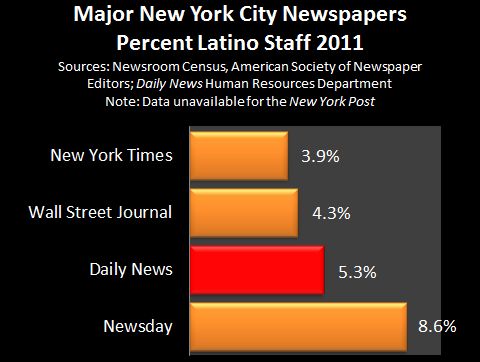
 The
The
and Latino Community
at a Crossroads?
By Angelo Falcón (June 23, 2012)
When the news got out last month that the New York Daily News was laying off three Latino staffers and ending the publication of its weekly Spanish-language publication, Hora Hispana , the question of this major newspaper's commitment to covering the Latino community became the buzz in our community. According to Scarborough Research, in 2011 the Daily News had close to 900,000 print and online Latino readers, representing over 28 percent of their total. This recent move by the paper's management understandably raised concerns among Latinos, given the widespread perception that the Daily News already had few Latino staff and an editorial leadership that is disconnected from our community.
My colleague, Marta Garcia, wrote a letter of concern to their President and CEO, Bill Holiber, as well as their owner and other executives in May on behalf of the organization she founded and we co-chair, the New York Chapter of the National Hispanic Media Coalition. Then, making our point for us, there was the incident where, literally on the eve of the massive National Puerto Rican Day Parade in New York City in early June, the Daily News , one of the parade sponsors, made the colossal error of displaying the Cuban for the Puerto Rican flag in its major ad for the event , causing a major stir in the Puerto Rican community, the largest Latino group in the city. This story went viral and many made the connection between the paper's letting go of much of its Latino staff and this culturally awkward faux pas, despite the fact that the paper denied any connection between the two things.
The problem was that one of the staffers they had let go was a 15-year veteran of the paper, the extremely highly-regarded journalist Maite Junco, who was a deputy editor and editor of their Viva magazine supplement. Given that there seemed to be so few Latinos on their editorial staff, how could they afford to let such a seasoned professional from our community go with Latinos being such a big part of their audience? It didn't make sense to many of us.
As a result of our communication with the Daily News leadership, Marta had some telephone conversations with their President and CEO, Bill Holiber. They agreed that it would be helpful to have a meeting with him to discuss our concerns and on June 21st we did so. At Daily News headquarters down in the Wall Street area, Holiber and Jeff Zomper, their Senior Vice President of Human Resources and Administrative Services, met with Javier Gomez of the National Puerto Rican Day Parade, Lucia Gomez-Jimenez of La Fuente, Marta and me.
In preparing for this meeting, we did as much research as we could. Marta was able to get the data on their readership from our friends at Scarborough Research but we couldn't find any information on the Latino representation on the Daily News staff, which was our chief concern. The American Society of Newspaper Editors (ASNE) conducts an annual Newsroom Census
that collects such information, but Marta found that in the past year the Daily News had not participated in this survey! After she inquired with ASNE and Holiber, she found out that they had submitted their information after the deadline and so it did not appear with the full census results. We asked the Daily News to provide us with this information, but never received it before our meeting.
Experienced in institutional resistance to providing such information, through my work with NiLP, I had developed some creative "guerilla research" techniques over the decades to compensate and we generated our own analysis of their Latino work force. Using the Daily News' editorial staff listing contained in the the 2012 edition of the authoritative New York Publicity Outlets Directory, I found that of the 152 positions listed, only 7, or less than 5 percent, were held by Latinos! And, since that list was published, at least two of those had been let go. In the table below, you can see the breakdown by job title.

We were, frankly, taken aback by these numbers. Although there was a general perception in our community that the Daily News' track record of Latino hiring was poor, we think that the fact that they had two of the highest profile Latino columnists in the city, Juan Gonzalez and Albor Ruiz, gave the false impression that there was a larger Latino presence on their staff. But what we found was that in job category after job category, there were no Latinos employed at the paper at all! And, as I already pointed out, already some of these Latinos on this list had been let go!
At our meeting with Holiber and Zomper, we brought these numbers to their attention and asked them for their own employment data, as they had committed themselves to provide. Zomper presented us with their EEO data for 2012, which, as it turns out, were quite consistent with our independent findings: Latinos made up only 5.3 percent of their total staff.

Zomper pointed out that compared to the city's other major newspapers, their Latino hiring was better than that of the New York Times and the Wall Street Journal, but significantly behind that of Newsday. However, they only provided percentages and not the actual numbers, and did not provide the breakdown by job title as we did. By the way, the Daily News' major rival, the Rupert Murdock-owned New York Post, did not participate in the ASNE Census, so information on their Latino employment numbers is not publicly available.

The discussion on ways that the Daily News could be more inclusive of Latinos and improve its coverage of our community that followed was wide-ranging. This meeting was seen on both sides as preliminary to a larger follow-up meeting with the paper's executives and the city's Latino community leadership that Marta and the NHMC would be coordinating.
The paper had been downsizing over the past year and it was made clear that they were not doing much hiring on the editorial side. They were, however, expanding their sales force and pointed to more immediate opportunities for new Latino hiring in this area. On the editorial side, there were some indications that they planned to expand their national news coverage and that this might require some new hiring. We also discussed their increasing move to the Internet and the possibilities this created for greater Latino inclusion, such as using Latino bloggers. Their outreach to let the Latino community know of employment opportunities seemed to be to be much too limited and we discussed ways they could better reach out to our organizations and publications, such as the National Association of Hispanic Journalists, the National Hispanic Media Coalition and others.
We made the point that there was no significant Latino editorial presence and that there was a widespread feeling in the community that important decisions on what was worth covering and taking positions on were being done without much input from our community. It was suggested that it would be helpful to have a meeting with their editorial board to discuss their coverage of the Latino community and issues. Holiber pointed out that it would be important to educate his staff about the issues facing the Latino community and the importance of finding ways to be more inclusive at all levels.
The issues we raised with the Daily News are clearly not unique to them. The lack of inclusion of Latinos in all of the city's mainstream English-language newspapers is a growing problem. While same at the paper consider themselves to have a highly "diverse" work force while it is over 80 percent non-Latino White, there is obviously a serious problem of denial at play here. But, again, this is a problem that goes beyond the Daily News itself.
The bottom line is with Latinos making up at least 29 percent of the city's population, 28 percent of the Daily News readership, but only 5 percent of its reporters and other staff, this level of Latino exclusion from this paper's operations is a serious problem. And with the paper's management taking the position that they don't anticipate much hiring on th editorial side. It appears that not much is going to happen to change this situation. We hope in our future discussions with the Daily News leadership that we will be able to impress upon them to give this issue of Latino inclusion a top priority. The challenge is to, first of all, get the top decisionmakers at the paper to acknowledge the seriousness of the problem and then engage them in a partnershiuo with our community to develop concrete solutions.
In this sense, this Daily News meeting was only the beginning of a process of engagement with the paper in our effort to turn what were negative developments into positive ones for both the Latino community and them. This was, in essence, a fact-finding session for both the Daily News and us upon which to build on.
We made the point early in our conversation that being inclusive of Latinos is not only the right thing to do, but bottom line good business for the paper. This is a large market that cannot be ignored or marginalized, and a pool of talent and resources that would be foolish for the Daily News not to creatively invest in. Holiber made the point several times in our discussion that the Daily News is uniquely positioned as the hometown newspaper of the city's working class. Latinos arguably are the largest and most excluded part of that working class.
* * *
Angelo Falcón is President of the National Institute for Latino Policy (NiLP), where he edits The NiLP Network on Latino Issues. He also volunteers as co-chair of the
